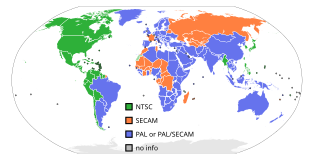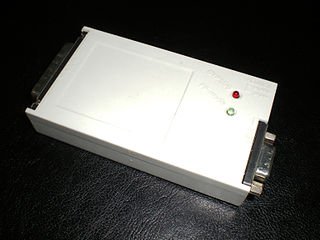
NTSC is the first American standard for analog television, published and adopted in 1941. In 1961, it was assigned the designation System M. It is also known as EIA standard 170.

Phase Alternating Line (PAL) is a colour encoding system for analog television. It was one of three major analogue colour television standards, the others being NTSC and SECAM. In most countries it was broadcast at 625 lines, 50 fields per second, and associated with CCIR analogue broadcast television systems B, D, G, H, I or K. The articles on analog broadcast television systems further describe frame rates, image resolution, and audio modulation.
Frame rate, most commonly expressed in frame/s, frames per second or FPS, is typically the frequency (rate) at which consecutive images (frames) are captured or displayed. This definition applies to film and video cameras, computer animation, and motion capture systems. In these contexts, frame rate may be used interchangeably with frame frequency and refresh rate, which are expressed in hertz. Additionally, in the context of computer graphics performance, FPS is the rate at which a system, particularly a GPU, is able to generate frames, and refresh rate is the frequency at which a display shows completed frames. In electronic camera specifications frame rate refers to the maximum possible rate frames could be captured, but in practice, other settings may reduce the actual frequency to a lower number than the frame rate.

Interlaced video is a technique for doubling the perceived frame rate of a video display without consuming extra bandwidth. The interlaced signal contains two fields of a video frame captured consecutively. This enhances motion perception to the viewer, and reduces flicker by taking advantage of the characteristics of the human visual system.

Telecine, or TK, is the process of transferring film into video and is performed in a color suite. The term is also used to refer to the equipment used in this post-production process.
Enhanced-definition television, or extended-definition television (EDTV) is a Consumer Electronics Association (CEA) marketing shorthand term for certain digital television (DTV) formats and devices. Specifically, this term defines an extension of the standard-definition television (SDTV) format that enables a clearer picture during high-motion scenes compared to previous iterations of SDTV, but not producing images as detailed as high-definition television (HDTV).
The refresh rate, also known as vertical refresh rate or vertical scan rate in reference to terminology originating with the cathode-ray tubes (CRTs), is the number of times per second that a raster-based display device displays a new image. This is independent from frame rate, which describes how many images are stored or generated every second by the device driving the display. On CRT displays, higher refresh rates produce less flickering, thereby reducing eye strain. In other technologies such as liquid-crystal displays, the refresh rate affects only how often the image can potentially be updated.
In video technology, 24p refers to a video format that operates at 24 frames per second frame rate with progressive scanning. Originally, 24p was used in the non-linear editing of film-originated material. Today, 24p formats are being increasingly used for aesthetic reasons in image acquisition, delivering film-like motion characteristics. Some vendors advertise 24p products as a cheaper alternative to film acquisition.

The display resolution or display modes of a digital television, computer monitor, or other display device is the number of distinct pixels in each dimension that can be displayed. It can be an ambiguous term especially as the displayed resolution is controlled by different factors in cathode-ray tube (CRT) displays, flat-panel displays and projection displays using fixed picture-element (pixel) arrays.
Deinterlacing is the process of converting interlaced video into a non-interlaced or progressive form. Interlaced video signals are commonly found in analog television, VHS, Laserdisc, digital television (HDTV) when in the 1080i format, some DVD titles, and a smaller number of Blu-ray discs.
Flicker is a visible change in brightness between cycles displayed on video displays. It applies to the refresh interval on cathode-ray tube (CRT) televisions and computer monitors, as well as plasma computer displays and televisions.

A flicker fixer or scan doubler is a piece of computer hardware that de-interlaces an output video signal. The flicker fixer accomplishes this by adjusting the timing of the natively interlaced video signal to suit the needs of a progressive display for example a CRT computer monitor. Flicker fixers in essence create a progressive frame of video from two interlaced fields of video.

576i is a standard-definition digital video mode, originally used for digitizing 625 line analogue television in most countries of the world where the utility frequency for electric power distribution is 50 Hz. Because of its close association with the legacy colour encoding systems, it is often referred to as PAL, PAL/SECAM or SECAM when compared to its 60 Hz NTSC-colour-encoded counterpart, 480i.

An active shutter 3D system is a technique for displaying stereoscopic 3D images. It works by only presenting the image intended for the left eye while blocking the right eye's view, then presenting the right-eye image while blocking the left eye, and repeating this so rapidly that the interruptions do not interfere with the perceived fusion of the two images into a single 3D image.
High-motion is the characteristic of video or film footage displayed possessing a sufficiently high frame rate that moving images do not blur or strobe even when tracked closely by the eye. The most common forms of high motion are NTSC and PAL video at their native display rates. Movie film does not portray high motion even when shown on television monitors.
Television standards conversion is the process of changing a television transmission or recording from one video system to another. Converting video between different numbers of lines, frame rates, and color models in video pictures is a complex technical problem. However, the international exchange of television programming makes standards conversion necessary so that video may be viewed in another nation with a differing standard. Typically video is fed into video standards converter which produces a copy according to a different video standard. One of the most common conversions is between the NTSC and PAL standards.
Display motion blur, also called HDTV blur and LCD motion blur, refers to several visual artifacts that are frequently found on modern consumer high-definition television sets and flat-panel displays for computers.
A multiple-sync (multisync) monitor, also known as a multiscan or multimode monitor, is a raster-scan analog video monitor that can properly synchronise with multiple horizontal and vertical scan rates. In contrast, fixed frequency monitors can only synchronise with a specific set of scan rates. They are generally used for computer displays, but sometimes for television, and the terminology is mostly applied to CRT displays although the concept applies to other technologies.

Motion interpolation or motion-compensated frame interpolation (MCFI) is a form of video processing in which intermediate film, video or animation frames are generated between existing ones by means of interpolation, in an attempt to make animation more fluid, to compensate for display motion blur, and for fake slow motion effects.